The Politics of No Child Left Behind - Hoover Institution
The Politics of No Child Left Behind - Hoover Institution
The Politics of No Child Left Behind - Hoover Institution
- No tags were found...
Create successful ePaper yourself
Turn your PDF publications into a flip-book with our unique Google optimized e-Paper software.
Conference <strong>of</strong> State Legislatures called the bill’s testing provisions“seriously and perhaps irreparably flawed.” And newreports argued that both the House and Senate provisionsfor adequate yearly progress would result in a large number <strong>of</strong>schools’ being identified as failing. On Capitol Hill, HouseRepublicans had calculated that with a Republican Senatethey could gain back their concessions in conference, but nowthat chance was gone. Democrats began to wonder too: afterall, didn’t the president need this bill more than they did?<strong>The</strong> conference committee, then, had to repair the bill’sbipartisan armor—and bridge some 2,750 divergences betweenthe House and Senate versions. It would not merely revise butrewrite many provisions that had been pushed through withthe promise <strong>of</strong> a later “fix,” maximizing the remarkable degree<strong>of</strong> discretion delegated to congressional conferees.During the summer recess, staff members representing all39 members <strong>of</strong> the conference—the Senate, to represent itscoalition’s various blocs, had named an astounding 25 conferees—metdaily to hammer out more than 2,000 agreements.Even September 11 and the anthrax scare did not push <strong>No</strong> <strong>Child</strong><strong>Left</strong> <strong>Behind</strong> <strong>of</strong>f the agenda.With periodic presidential exhortation, accountability provisionsslowly took shape under the watchful eyes <strong>of</strong> the “BigFour”: Boehner, Miller, Kennedy, and Gregg. Language providingadditional targeting <strong>of</strong> compensatory education fundsto poor districts was approved. A pilot block-grant program wasgrafted to “transferability.” Final supplemental services languagewas developed. Extra money for charter schools wasfound (though money for special education was not; indeed,most <strong>of</strong> the Senate’s funding levels were slashed). Announcedlast, or nearly so, were the adequate yearly progress requirements.While the conference’s basic stance on this was in placeby late September, it was kept quiet to allow additional tinkeringand to avoid interest group pressure.<strong>The</strong> final language required all students, in all groups, toreach pr<strong>of</strong>iciency within 12 years. However, it allowed districtsto average results across three years. <strong>No</strong> punishmentwould be imposed on states for low test scores. And thoughBush endorsed “an objective check on state accountability systems”(specifically naming NAEP), this issue was settled byrequiring states to participate biennially in the 4th- and 8thgradeNAEP exams, but prohibiting penalties based on thestates’ NAEP performance. <strong>The</strong>se changes, though hardly satisfyingall critics, made the final version more workable thaneither the House or Senate versions.At once numbingly detailed and comfortably vague, theconference report was adopted by the House and Senate inDecember, with opposition again limited to an odd amalgam<strong>of</strong> the discontented far <strong>Left</strong> and far Right. <strong>The</strong> process, saidRoemer, had “brought the middle together, and held it.” Animpressive legislative victory was in place.<strong>The</strong> Implementation ChallengeMany factors contributed to <strong>No</strong> <strong>Child</strong> <strong>Left</strong> <strong>Behind</strong>’s passage:the tentative alliance between moderate New Democrats andmuch <strong>of</strong> the Republican caucus; the need for the newly electedpresident to succeed on a campaign priority; Bush’s willingnessto embrace Democratic positions and leaders; and the mediaattention that resulted from the debate’s “man bites dog” quality—aRepublican president pushing a supposedly Democraticissue.Cooperation among legislators was made possible by thewillingness to move past divisive issues—itself possible becausethe conversation was newly framed by a common vocabularycentered on “accountability.” Accountability was hard to beagainst, but elastic. It served as a way for Democrats to talk aboutreform without simply talking about increased spending; it wasalso a selling point for additional resources, since ordinarily skepticalRepublicans could console themselves that the new fundswent to a system newly worthy <strong>of</strong> investment. While accountabilitywas unproved as a reform tool, there was also no conclusiveevidence that it did not work. In the absence <strong>of</strong> empiricism,aphorism took hold, as with Secretary <strong>of</strong> Education RodPaige’s athletic metaphor: “If you want to win the footballgame, you have to first keep score.” How one defines accountabilitymatters greatly in practice, but it proved to matter farless in politics—in other words, to the term’s usefulness in providinga unifying theme for the <strong>No</strong> <strong>Child</strong> <strong>Left</strong> <strong>Behind</strong> debatethat could garner broad agreement in principle even whenpolicy specifics proved elusive.<strong>The</strong> latter could be compromisedor, as <strong>of</strong>ten happened,deferred from campaign to committeeto floor to conference to implementation. But when the billbecame law in 2002, it could be deferred no longer.<strong>The</strong> compromises <strong>of</strong> <strong>No</strong> <strong>Child</strong> <strong>Left</strong> <strong>Behind</strong> avoided bothextremes <strong>of</strong> the policy spectrum. Democrats, for example,resisted granting wide discretion to local districts on the onehand and to parents on the other. <strong>The</strong> number <strong>of</strong> categoricalprograms did not diminish significantly. In principle, publicschool choice has been greatly expanded, but it is not clear howwell this will serve students in far-flung rural districts or in urbansystems where most or all <strong>of</strong> the public schools are identifiedas needing improvement. And experimentation with voucherprograms will have to await the baby steps <strong>of</strong> the supplementalservices program and continued local efforts, albeit encouragedby the Supreme Court’s June 2002 Zelman decision.Meanwhile, Republicans resisted efforts to require strongstate accountability to the federal government. <strong>The</strong> first bulletpoint in the House fact sheet on the conference reporttrumpeted, “<strong>No</strong> National Tests.” <strong>The</strong>re are no consequenceslinked to NAEP participation or for states that fail to attainadequate yearly progress. <strong>The</strong> text <strong>of</strong> the law left the states toset their definition <strong>of</strong> pr<strong>of</strong>iciency and to use their own assessmentsto measure it, leaving open the possibility that states willlower their expectations.68 EDUCATION NEXT / FALL 2003 www.educationnext.org









